The Discoveries of Cave Paintings In the Excavations of Altamira In Cantabria Spain
Altamira, a cave in Cantabria, Spain was one of the first recognized decorated caves. It’s famous for the outstanding artistic quality of the paintings it contains, as well as the quantity of motifs preserved. The subject matter of the painting is dominated by animals, such as horses, bison, bulls, and goats. (Conkey 1980:611)
There are a few humans depicted as well as an abundance of hand stencils. The limited color palette includes different hues of black, yellow, and red. These colors were obtained from charcoal, burned bones, manganese oxides, and other iron oxides. (Guthrie 2005:13) The cave itself is actually a series of various passages.
In its entirety, it is 270 meters long and height varies from 2 to 12 meters and the width from six to twenty meters. (Conkey 1980:609) Its contents were preserved when a rockfall, 13,000 years ago, sealed the entrance. The cave remained undiscovered until 1868 when detonations from a nearby rock quarry created a crack. (Conkey 1980:610)
Order custom essay The Discoveries of Cave Paintings In the Excavations of Altamira In Cantabria Spain with free plagiarism report
 450+ experts on 30 subjects
450+ experts on 30 subjects
 Starting from 3 hours delivery
Starting from 3 hours delivery
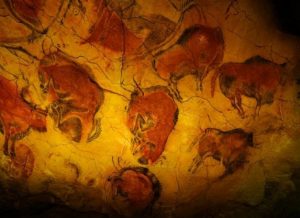 Male and female Bison painted on the ceiling of Altamira Cave
Male and female Bison painted on the ceiling of Altamira Cave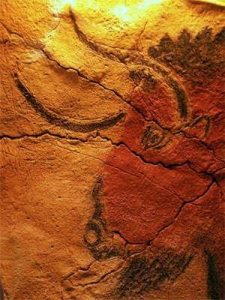
Discovery and Excavations
Marcelino Sanz de Sautuola, a wealthy landowner with a degree and law and an interest in archaeology, had been unearthing animal bones and stone tools from the floor of the cave’s entrance since 1976. The cave’s paintings were discovered in 1879 his eight-year-old daughter Maria.
For two years, Sautuola and Juan Vilanova y Piera of the University of Madrid excavated the cave. (Conkey 1980:609) The discoveries generated controversy about whether or not the findings were authentic. Many thought that a modern artists created the paintings because ancient humans were not capable of art.
It was not until 1902 that the existence of Paleolithic art was accepted by the scientific community. (Abadia 2004:321) Altamira contains the earliest known examples of Stone Age painting. They were painted using an airbrush method that involved setting one hollow bone perpendicularly in a container of ochre, and holding another hollow bone in the artist’s mouth. The artist would then blow across the open hollow bone and force the ochre up the vertical bones and onto the surface of the rock. (Garcia-Diez 2005:19)
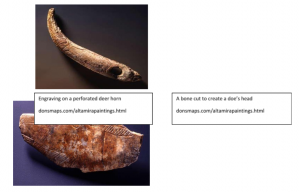
A second excavation was completed by Ermillo Alcalde del Rio from 1903 and 1905. He excavated approximately 20 square meters of the entrance. He differentiated between two large stages, the Solutreana and the Magdaleniana, using the color and texture of the soil, and the varying presence of limestone pebbles and marine shells. (Conkey 1981:22)
The first level has a thickness of .45 meters and the second of .80 meters. This level is where a lot of the portable art, such as the engraved shoulder blades of stags and bison, was found. (Abadia 2004:334)
From 1924 to 1925, Hugo Obermaier widened the area of excavation by 10 meters squared. He excavated to 2.5 meters, where rocky soil prevented him from going any deeper. He found Font Robert projectile points which are indicative of the Perigordian period (dated 35,000 BP-20,000 BP) and of very early occupants. (Guthrie 2005:43)
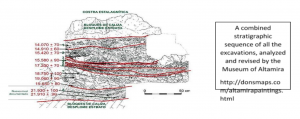
The latest excavation was done by Joaquin Gonzales Echegaray and L.G. Freeman in 1981. They decided to excavate an intact vestibule as opposed to the entrance. They limited their excavation to the upper Magdalenian level and found artefacts such as an engraved deer shoulder blade and bone and stone tools. (Straus 2000:3)
These dates vary between 18,500 BP and 13,900 BP. During the Magdalenian period, the art work became more varied and the number of animal species depicted increased. There were more mountain goals and deer, as well as semi-human faces. There are also numerous small back strokes make throughout the caves which seemingly have no function nor regularity. (Straus 2000:6)
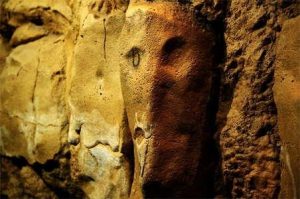
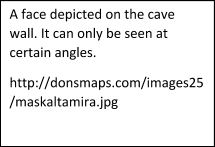
Dating
The Altamira paintings were dated in 2008 using uranium-thorium dating, in which a uranium series is applied to the calcifications. While the accuracy of this dating technique is still being debated, the results showed that the paintings were completed over a period of up to 20,000 years. (Garcia-Diez 2013:4104)
Excavations of the cave floor found deposits of artefacts from the Upper Solutream period (dated at 18,500 years ago) and from the Lower Magdalenian Period (dated at 16,500-14,000 years ago.) The portable art has been dated by radiocarbon to 14,480 years ago. (Abadia 2004:328) The oldest works found belonged to Aurignacian culture and were dated at 35,000 years ago which also marks the beginning of human occupation of Northern Spain. (Garcia-Diez 2013:4101)
Significance
The work done at Altamira truly changed the way archaeologists and anthropologists perceived prehistoric human beings. The paintings and rock engravings are the most visually powerful examples of Paleolithic art and culture, especially because they are so numerous and vividly colored.
Since it is the earliest instance of Paleolithic art, it contributes to modern day humans understanding the beginning of culture and art. (Guthrie 2005:23) It also gives insight into the mental capacities of prehistoric humans. Late 19th century scholars viewed prehistoric humans as only capable of violence and savagery but Altamira shows that art was most likely used as a social-cultural device that promoted cohesion, not conflict.
References Cited
- Guthrie, Dale R 2005 The Nature of Paleolithic Art. The University of Chicago Press. Chicago, IL Garcia-Diez, Marcos 2013
- Uranium series dating reveals a long sequence of rock art at Altamira Cave. Journal of Archaeological Science 40(11): 4098-4106.
Conkey, Margaret - 1980 The Identification of Prehistoric Hunter-Gatherer Aggregation Sites: The Case of Altamira. Current Anthropology 21(5): 609-630.
- 1981 A Century of Palaeolithic Cave Art. Archaeology. 34(4): 20-28
- Abadia, Oscar M 2004 Towards a Genealogy of the Concept of "Paleolithic Mobiliary Art" Journal of Anthropological Research. 60(3): 321-339
- Straus,Lawrence G 2000 Leslie Gordon Freeman: An American in Spanish Prehistory. Journal of Anthropological Research 56(1): 3-6
Cite this Page
The Discoveries of Cave Paintings In the Excavations of Altamira In Cantabria Spain. (2020, May 14). Retrieved from https://phdessay.com/the-discoveries-of-cave-paintings-in-the-excavations-of-altamira-in-cantabria-spain/
Run a free check or have your essay done for you


